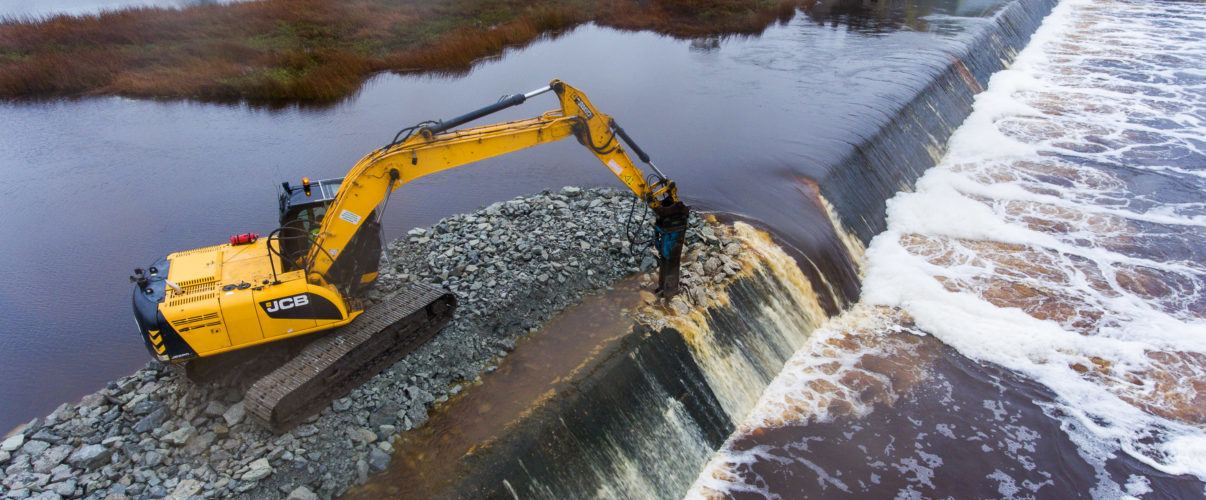Groningen, The Netherlands (April 25, 2023) – A new report by Dam Removal Europe reveals another record-breaking year for river barrier removal in 2022. A new country has also joined the movement.
The dam removal movement set a new record in Europe in 2022 with at least 325 river barriers coming down across the continent – a 36% increase on the previous record set in 2021.
The latest report reveals the surprising statistic that (at least) 325 barriers were removed in 16 European countries last year– a new record! As in 2021, most of the removed barriers were weirs, as these structures have a high probability of being old and obsolete and can be removed in a cost-efficient way. Several factors contributed to the new numbers, such as newly available funding opportunities, like the Open Rivers Programme, the coordinated efforts of national and regional public authorities to report removed barriers, and the enthusiasm created by the findings of last year’s report, disseminated all around Europe.
As Yurena Lorenzo, European Programme Manager at Wetlands International Europe, states
“Seeing the numbers of barrier removals increase year-after-year is a great achievement for Dam Removal Europe’s coalition. This is proof of the successful mainstreaming process of barrier removals as a key restoration tool which is emerging increasingly from not only bottom-up initiatives, but also top-down ones thanks to newly integrated policies.”
The podium for Europe’s top dam removers remained the same, with Spain reaffirming its place at the top of the list, followed by Sweden and France. However, new faces joined the movement. Luxembourg recorded its first-ever barrier removal, removing a weir. The removal was part of a bigger project aimed to restore the ecological continuity of the Pétrusse River.
For Herman Wanningen, Director of the World Fish Migration Foundation, it is important to highlight such positive cases, to show how dam removal operations can be replicated and scaled up across the globe: “We started a riverlution, but only with the joint action of river practitioners, authorities, policymakers, and citizens, will it be possible to achieve the EU Biodiversity Strategy targets.”
Given the latest developments in European climate policy and the European Commission’s proposal for a Nature Restoration Law, it is important to keep highlighting dam removal as a crucial tool to accomplish ecosystem restoration and celebrating success stories across Europe.
“The global community set a critical target in late 2022 that at least 30% of freshwater ecosystems are protected by the end of the decade. The acceleration we are seeing in barrier removals year-on-year in Europe is an important sign of progress that we are proud to support. The ‘old continent’ is now leading the way in this area: we must get all hands on deck to redouble efforts to reach and hopefully overshoot the EU target of 25,000 kilometres of free-flowing rivers by 2030,” said Sophie Trémolet, Europe Freshwater Director for The Nature Conservancy.
Moreover, barrier removal also contributes to the global Freshwater Challenge to restore 300,000km of degraded rivers by 2030, a goal launched at the UN Water Conference held in New York in March.
Besides pollution, habitat degradation, and over- exploitation of natural resources, freshwater ecosystems face another major issue: dams. According to Pao Fernández Garrido, Project Manager at Dam Removal Europe, “ Rivers are essential components of our ecosystems, providing water for agriculture, transportation, and food. River barriers, such as dams and weirs, have caused detrimental effects on nature, harming not only biodiversity, but also the communities that depend on these waterways. It is thus our generation’s mission to start taking some of these barriers down and restore free-flowing rivers for all.”
It has been found that over 1.2 million barriers fragment European rivers, many of which are obsolete. Among the several harmful consequences is biodiversity loss, with a decline of 93% in freshwater migratory fish populations in Europe and 76% on a global level. The alarming numbers demand cost-effective and efficient solutions to restore rivers. Dam removal has been paving its way as a nature restoration tool – a trend confirmed across Dam Removal Europe’s annual reports.
“Dam removal is a key element of rewilding, as it helps to revive the natural flow of rivers, restore habitat for native species, and re-establish the ecological processes that are essential for a healthy, functioning ecosystem”, says Raquel Filgueiras, Head of Rewilding at Rewilding Europe.
The report is available for consultation or download here.
For any queries, please contact the Dam Removal Europe Communications Team:
Maria Inês Conceição, [email protected], +351 913926675
About Dam Removal Europe
Dam Removal Europe (DRE) is a coalition of 7 organisations: the World Wildlife Fund (WWF), The Rivers Trust, The Nature Conservancy, the European Rivers Network, Rewilding Europe, Wetlands International, and the World Fish Migration Foundation. The ambition of DRE is to restore the free-flowing state of rivers and streams in Europe. In that respect, DRE aims to establish barrier removal as a restoration tool and to mainstream this practice. More information: www.damremoval.eu

